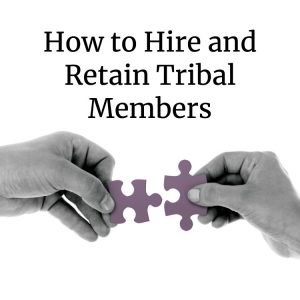What’s harder than finding good talent in a tightening labor market? Keeping good talent. As a leader in a tribal organization, you’re no stranger to the rigors of talent acquisition and retention. The fallout caused by a bad hire extends far beyond frustration to include high recruiting costs, lost productivity, and low team morale. With your organization’s bottom line and culture at stake, you can’t afford to make a bad hire. Implementing a strategic and effective hiring process is the foundation for attracting and retaining highly skilled tribal members.
Why Hire Tribal Members?
Hiring tribal members to fill open positions plays an integral role in sustaining the long-term growth and success of your Tribe. There are a host of reasons to hire tribal members including self-sufficiency, career development, tribal preference, and development of future leaders.
Hiring the Best Candidate
Sourcing top talent can feel like finding a needle in a haystack at times. However, adopting a strategic and purposeful recruiting process is the critical first step in the employee lifecycle. Too often, organizations hastily post jobs and haphazardly review candidate profiles to quickly fill a gap.
Instead, analyze your staffing needs from a macro view. Consider forecasting projected growth, organizational deficits, and desired skill sets. Only when preliminary planning is complete should you proceed with crafting a targeted job description that clearly defines essential job functions and required competencies.
The next step is to screen candidates. Review resumes, conduct basic interviews, and you’re done, right? Not so fast. Finding the best fit for your Tribal organization requires careful, and even clinical, vetting. That’s right – science has made its way into the recruiting process by way of psychometric testing – a standard and scientifically validated method for evaluating an individual’s suitability for a role. This type of assessment can determine whether a candidate’s personality and aptitude are a good fit for the job as well as your company culture. Psychometric testing can be done online and easily integrated into the pre-screening stage. Use the test results to decide which candidates you should bring in for an on-site interview.
The key to unlocking a candidate’s potential and the likelihood of success within your Tribal organization is to ask pointed, probing questions. Presenting behavioral and situational questions that require the candidate to explain how and why they would react in certain scenarios, will reveal key insights. Be sure to ask questions that will encourage the candidate to elaborate on education, experience, career goals, and challenges.
All Aboard – Onboarding 101
Once you select and hire the candidate best suited for the job, it’s time to get them acquainted with the landscape of your tribal workplace. Onboarding is an essential part of employee engagement and job readiness. The onboarding phase should include a formal orientation, building tour, introduction to team members, and a comprehensive overview of office rules and procedures.
It’s important to note that onboarding shouldn’t be treated as a fleeting, one-day exercise in checking boxes. Instead, it marks the beginning of an ongoing commitment to employee training and development through regular check-ins, discussions about purposeful work, and assigning tasks aligned with their skills and interests. Onboarding is also an appropriate time to introduce a mentor or coach to support employees as they navigate through all aspects of their new role and organization.
Looking for onboarding best practices? Click here to download our latest checklist.
Mastering Performance Management
As a workforce leader, you know that having a sensible and structured performance management system in place is critical to the success of your tribal organization. When implemented effectively, this component of the employee lifecycle fosters engagement and promotes organizational growth. Performance management is optimized when it has clarity, communication, and consistency.
Recruiting, hiring, and retaining top talent is an intensive process when done effectively. Avoiding a potential bad hire means committing to the entire employee lifecycle. Contact us today to learn more about how we can help enhance your tribal organization’s talent acquisition processes.

